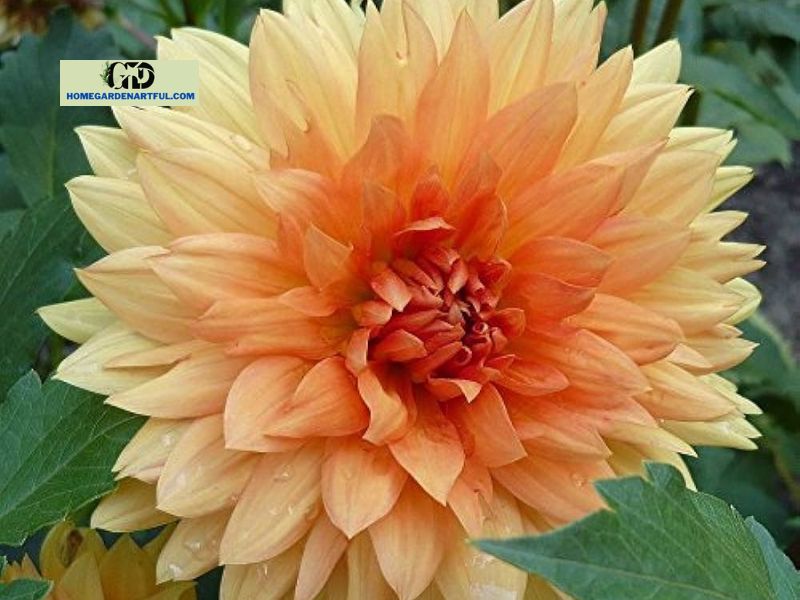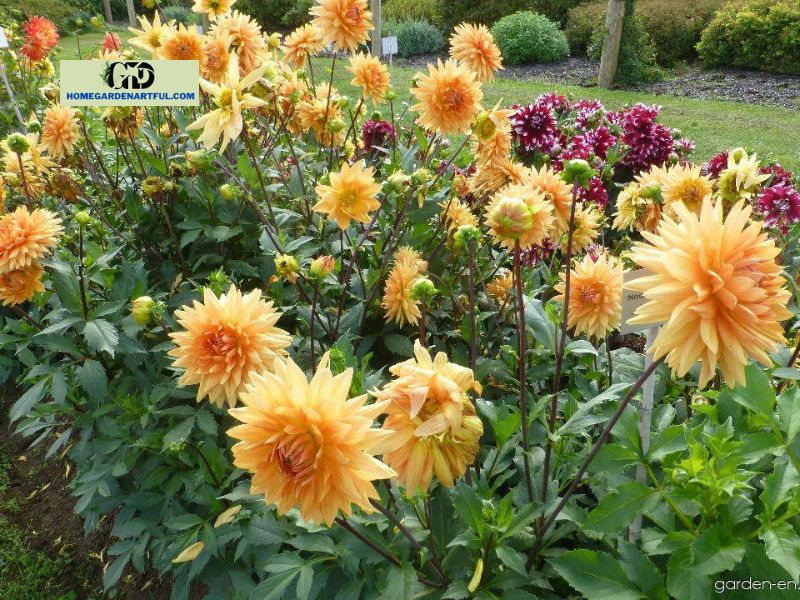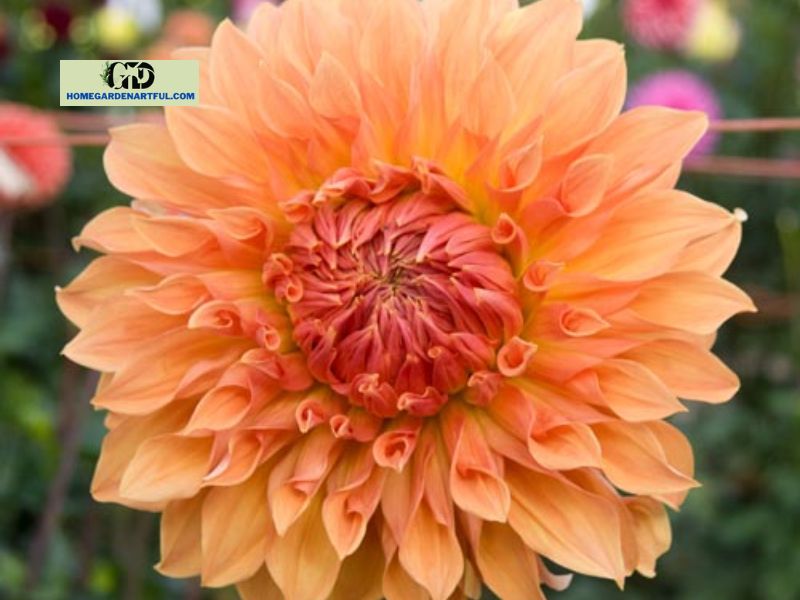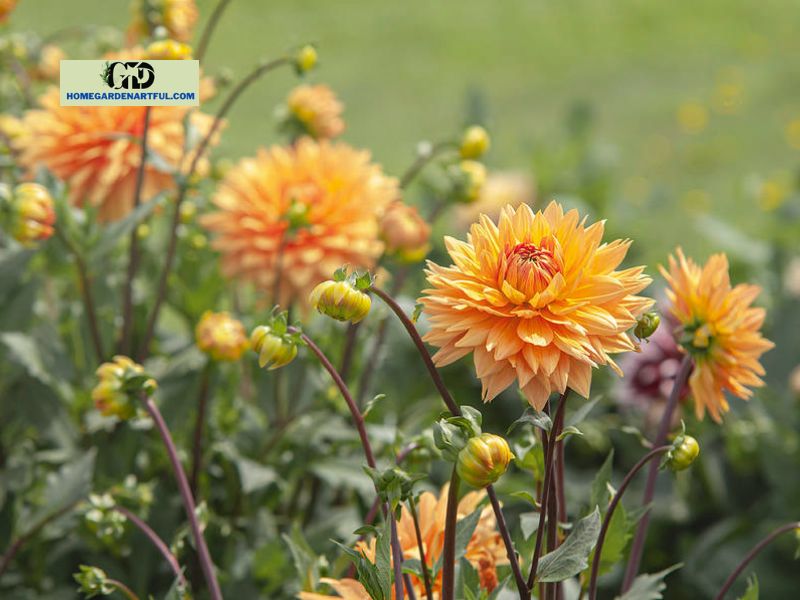The Noordwijks Glorie Dinnerplate Dahlia is an amazing variety for dinner plates, with flowers up to 20 cm in diameter! This Dahlia bears flowers from summer to fall and can reach a height of one meter.
Whether planted in big pots on a patio or in flowerbeds within the yard, the yellow-orange blossoms always have a radiant appearance. Like other dahlias, the towering flowers make excellent cut flowers for a vase or bouquet. Discover at homegardenartful.com!
Basic Care Guide for Noordwijks Glorie Dinnerplate Dahlia

Water
The Noordwijks Glorie Dinnerplate Dahlia requires extra water because it its huge, lush leaves. Noordwijks Glorie Dinnerplate Dahlia is neither drought nor water-accumulation resistant, nevertheless, because the roots are mushy and decay easily. When there is a drought, watering should be done immediately, and during the rainy season, drainage should be taken care of. Less water is needed in the early stages of seedling growth, and on bright days, it can be watered once daily. It needs a lot of water in its later stages of growth, thus on sunny days, the amount should be appropriately increased. Watering Noordwijks Glorie Dinnerplate Dahlia both before and after sunrise or dusk is recommended.
Fertilizer
Noordwijks Glorie Dinnerplate Dahlia prefers rich soil for fertilization. Once every ten to fifteen days, a light liquid fertilizer should be administered to the seedlings. In the early stages, nitrogenous fertilizer should predominate, and in the latter stages, phosphate-potassium fertilizer. Fertilizer can be administered once every 7–10 days after flower buds appear.
As soon as color starts to appear in the flower buds, fertilization should be halted. Furthermore, high temperatures should not be used for fertilizing. The growth conditions determine how much fertilizer is needed. A lack of fertilizer may be indicated by light and bare leaves. Yellowing leaf tips or scorched leaf margins could be signs of overfertilization. Thick, dark green leaves are a sign of appropriate fertilizer.
Sunlight
Noordwijks Glorie Dinnerplate Dahlia prefers to thrive in partially shaded areas since flowering requires 10 to 12 hours of sunlight, which is not ideal for intense sunlight. It is best to avoid direct sunlight when growing seedlings in the summer. Long-term shade exposure, however, can also result in stunted growth, weak roots, slender leaves, thin stems, little flowers, light-colored blossoms, or perhaps no blossoming at all.
Pruning
Excessive axillary buds must be cut and eliminated as soon as they sprout, to maximize nutrition distribution and minimize nutrient waste, in order to produce large, brightly colored flowers.
Furthermore, lateral buds frequently form next to the main branch’s flower buds. Such lateral buds will compete with flower buds on the main branch for nutrition if they are not removed in a timely manner, which will reduce the size of the flower.
At the base of the root, many new buds may sprout, and three to four healthy ones may remain. The main branch can be chopped off after the blossoms have faded, and the young buds will still develop into flowers.
Advanced Care Guide

Temperature
Native to Mexico, Guatemala, Colombia, and other nations, Noordwijks Glorie Dinnerplate Dahlia is found in highland regions at elevations above 1500 meters. It prefers dry, cool temperatures but is not resilient or resistant to heat. It may therefore grow healthily at 5 to 35 °C. The ideal range of temperatures is 10 to 25 °C. It thrives and blooms most when there is a temperature differential of at least 10 °C between day and night.
Soil
Loose, sandy soil that drains well is ideal for Dahlia ‘Glorie van Noordwijk’ cultivation. Each year, the culture soil or planting site should be switched. Plants that are continuously planted in the same soil have a tendency to deteriorate and become more vulnerable to illnesses and pests. It is normally advised to use a soil mixture of garden soil (50%), sandy soil (20%), leaf mold (20%), and organic fertilizer (10%) while potting dahlia ‘Glorie van Noordwijk’. Compacted soil cannot be utilized because it readily allows water to build up and causes root rot. Regular loosening of the soil is necessary to improve air permeability.
Planting, Harvesting, and Propagation

Noordwijks Glorie Dinnerplate Dahlia is primarily propagated by root division, cutting, and sowing. One popular technique is root division, which is simple to use, has a high survival rate, and promotes healthy seedling growth. Early spring is the best time to extract the stored tubers, cut off the rotten roots, as well as plant the tubers at 15 °C. When 1 cm of buds start to form, wait, divide the tubers, and plant each one separately. A tuber can generate roughly five buds and five seedlings using this strategy.
However, the primary technique for propagating Noordwijks Glorie Dinnerplate Dahlia is cutting because it has a greater survival rate and speeds up roots. The buds on the root tuber can be removed and placed in clean, moist sandy soil once they reach a size of 3 to 5 cm and the first pair of leaves on the new bud base spreads. After cutting insertion, thoroughly wet the soil. Use a spray bottle to retain moisture and keep the relative humidity between 70% and 75%. The largest percentage of seedling survival occurs at temperatures over 25 °C. Usually, the buds take root a week or so later. It takes around fifteen days for them to be ready for transplanting after rooted. In general, seeding is utilized in breeding; Noordwijks Glorie Dinnerplate Dahlia blossoms one to two years following sowing.
Seasonal Safety
In summer, if after a string of overcast days, there comes an unexpected burst of sunshine, mist the leaves to swiftly chill them down; otherwise, they would scorch and become yellow. When temperatures are high and there isn’t any rain, immediately apply a cooling spray in addition to watering.
Because Noordwijks Glorie Dinnerplate Dahlia is not very hardy, the withered plants above ground should be removed before the winter arrives, leaving only 10 to 15 centimeters of root collar. You have two options: either dig the root out of the ground or relocate the entire flowerpot inside.The tuber should be buried in moist, sandy soil in a room with a maximum temperature of 5 °C after being kept in a cool place for one to two days. Another option for storing the root is to use sawdust and keep it between 3 and 5 °C.


